
Pine straw vs. mulch. Learn about how you can use pine straw as mulch in your garden beds. Learn how to use this ecofriendly and affordable mulch.
This post may contain affiliate links which may earn me commissions should you click through them and take certain actions. As an affiliate for Amazon, Cricut, xTool, Home Depot, and other sites, I earn from qualifying purchases. Please DIY carefully. View my full legal disclosures here.
Please read the whole post so you don’t miss any important information!
While traditional wood mulch is the typical option for mulching a garden bed, I decided to look into pine straw as mulch after it was recommended for use with blueberry bushes.
Last year I over did it with a huge vegetable garden and this year I decided to seed the garden over with grass seed, use a Garden Tower for my vegetables, and keep a thin berry garden along our fence. My kids eat a lot more berries than they eat cucumbers so I wanted to grow what we’ll eat the most of. I also wanted to refocus on just a few items so I wouldn’t get overwhelmed with my garden this year. Sometimes it’s a lot to learn to grow multiple things in one year.
Our garden focus is: blueberry bushes, a blackberry bush, and some grape vines. Most were here last year, although I relocated the two blueberry bushes and bought a few more to add to the row.
The main concern with that area is that we get a lot of water running down along that fence line. We created a water garden and path for the front yard along that side as a result, but we’re still struggling with water drainage in the back. There was no way that regular mulch wouldn’t be dragged away with the rain.
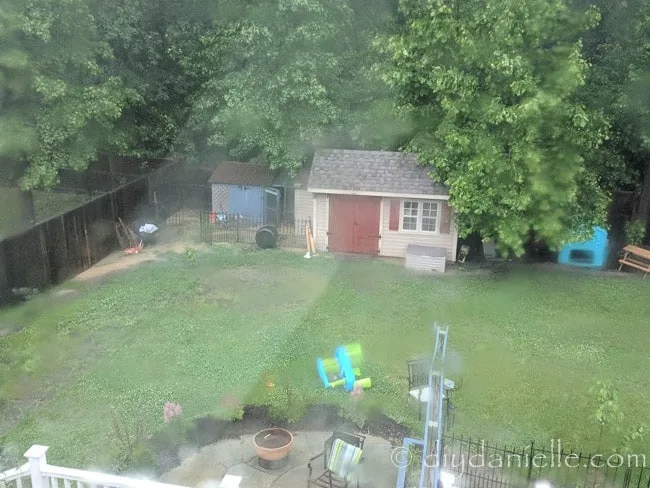
It’s a bad photo through the window during a bad rain storm, but as you can see the back floods pretty bad. My plan for this summer is to move the blue shed to the dog pen area and to remove the black fencing. Then I’ll try to plant some thirsty plants in the back there. Still need to figure out how we will move that shed though. Haha.
Okay so let’s talk pine straw.
What is Pine Straw?
Pine straw is pine needles. That’s it. Lots and lots of pine needles. There’s still sticks and pine cones mixed in. Probably some bugs. It’s dried, not fresh obviously.
You could DIY this type of mulch product if you have a pine forest nearby and a lot of energy. Or you can just buy the pine needles in compressed bags like I did from a local nursery. I had to call around quite a bit before I found a place that carried it, but you can also order it on the interwebz. It’s VERY lightweight which is nice for transporting it.
Pine straw is ecofriendly because no trees need to be cut down to create it… pine trees shed all year and the pine needles can be raked up and cleans, then packaged for transport. It can be purchased in bales (or in plastic packaged bales like I got).
It takes longer to break down than traditional wood mulch so it will last longer and need to be replaced less frequently. When it breaks down, it adds important nutrients to the soil. It’s useful for plants that like more acidic soils such as blueberries. Some plants will thrive more with this type of mulch and some will not.
Because it’s lightweight, it’s less likely to compact the soil than a heavier mulch and you can even mix the straw into the soil to help prevent soil compaction.
Like using regular straw for mulch, pine straw can help keep the soil warmer in the winter and protect plants that could come back next year (I usually cover my strawberries with straw). The pine straw also keeps the soil cooler in the summer. The pine straw forms a mat so it’s less likely to float away with heavy rain, but it’s still able to let rain through. It forms a good barrier to prevent weeds. The nice thing is that unlike straw mulch, it doesn’t usually come with weed seeds inside it. Every time I mulch with straw I have issues with weeds so I’m hoping the pine straw is better. Everything I’ve read says it will be.
Overall, it seems like it’s a more economical and environmentally friendly alternative to wood mulch.
The bad part of pine needles has been that they’re a bit sharp to work with and I doubt they’ll be pleasant to walk through with sandals and shorts this summer. I’m looking forward to seeing how it is once it forms a big mat.
My main concern is that it might be a haven for ticks and other creepy crawlies. While I try to remain calm about bugs in the garden- where they belong- I’m a bit sensitive about the tick infestation situation behind our fence. I’ve had Lyme and I loathe picking ticks off myself, the dog, and the kids so I just try to be proactive about prevention.
Read more about ticks in the following posts on DIYDanielle.com:
Ticks and Tick Removal | How to Prevent Ticks in Your Yard | What are Ticks, What Diseases do they Spread, & Should I Be Worried?
Pine Straw Vs. Mulch
Technically you can ‘mulch’ (verb) with many different products- pine straw being one of them. But generally when people think of mulch, they’re thinking of the pieces of wood that landscapers use.
First let’s talk about mulch types– you have pine straw, straw, and wood chips. But there are other options- for example, cocoa mulch, grass clippings, leaves, compost, seaweed, corn cobs, living mulch (plants with ground cover), weed fabric, stone, and plastic.
We’re going to focus on pine straw vs. mulch, but I’ve been really keen on moving from regular mulching to using cover crops (living mulch) because it’s less work (in my opinion). I’m a HUGE fan of less work. And each type of mulch is more ideal for different types of gardens.
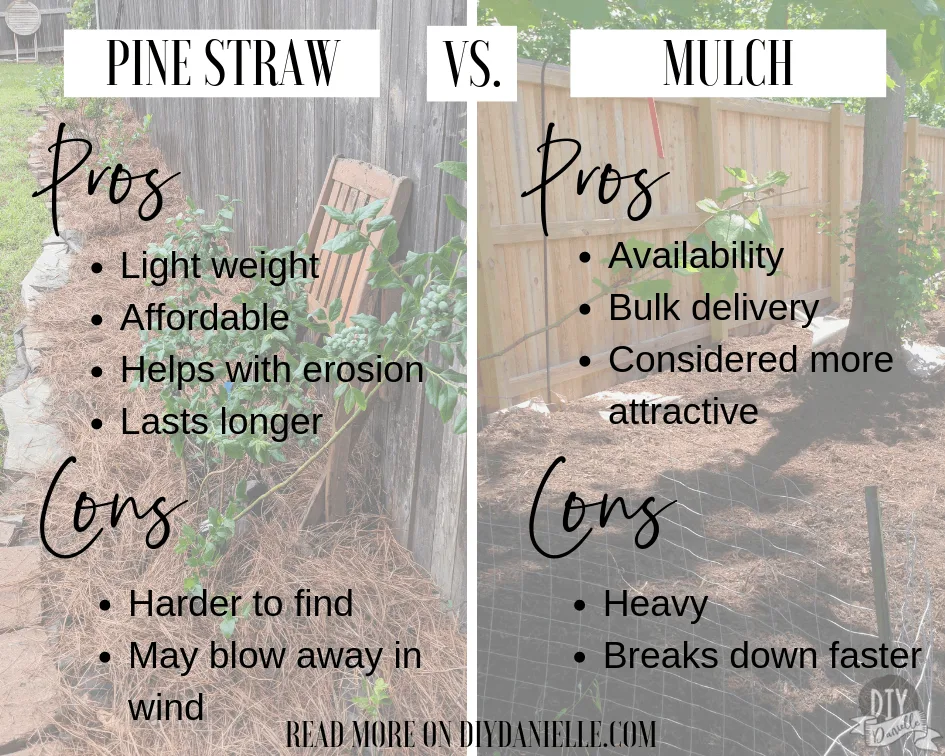
Pine Straw Pros
- Lasts longer
- Affordable
- Light weight bags are easier to haul around if you have issues with your back
- Helps with erosion- when used properly, the pine straw locks together and should not blow or wash away.
Mulch Pros
- Most people prefer the appearance of wood mulch
- Easy to find and more landscapers are familiar with using it.
- Bulk delivery is available.
A friend of mine mentioned that snakes are more attracted to pine straw, but to be honest I saw more snakes in my wood mulch than I did in the pine straw. I’m not sure if they just blend into the pine straw better, but I never saw a snake in there. I am, however, concerned that they might harbor ticks, but honestly I’m not sure there’s any avoiding that.
What Plants Like Pine Straw?
Plants that love acidic soil will like pine straw mulch:
- Blueberries
- Strawberries
- Cranberries
- Garlic
- Mint
- Raspberries
- Tomatoes
- Potatoes
- Onions
- Hydrangeas
- Rhododendrons
- Camellias
- Columbine
- Daisies
- Mums
- Roses
- Yarrow
- Iris
- Hostas
- Orchids
- Jasmine
- Holly
I wouldn’t use pine straw in a garden bed with really low lying plants. My front gardens have a lot of ground cover plants and I think they would get covered by pine straw pretty easily. This is a fluffy mulch and good for the taller plants like my berry bushes and vines.
For my front garden, I’ve been mulching once a year, then just doing a lot of weeding. I have a lot of ground cover plants though that are slowly creeping out and covering the garden and I’m hoping eventually the weeding will be minimal because they’ll hog the resources in the garden. I don’t know enough about flower gardening to say if that will work- but I think it’s a good theory and I hope it does. My motivation to do a better job in the flower garden is low. I like edible gardens better.
How Much Pine Straw Do I Need?
How much pine straw you need will depend on the size of your garden. You need to calculate the square footage of your garden area. Depending on where you purchase your bale, they have different amounts of coverage.
This pine straw coverage calculator might be helpful, but keep in mind that your bale or bags of pine straw may hold a different amount. I think these bags that I bought say they cover 100 Sq Ft, but they’re compressed in that bag pretty tight.
You don’t want more than a 2-4″ layer of pine needles or you risk preventing water from reaching your plant roots.
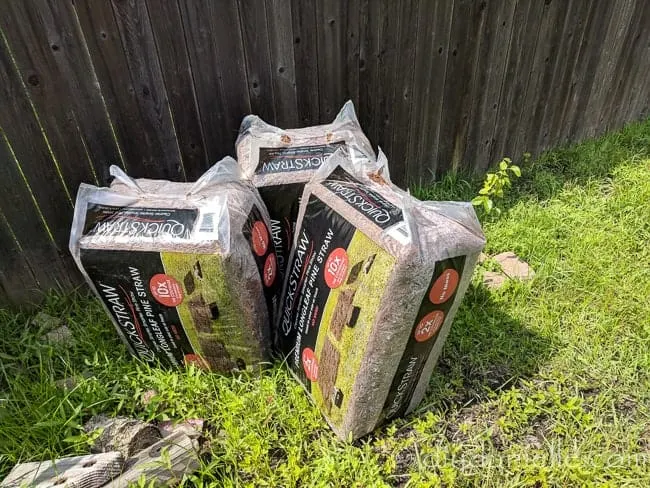
How to Spread Pine Straw
Pine straw should be applied once per year, as needed. You may find that it lasts longer than that, however.
Use gloves.
You may want to use gloves to spread this. I did not, but I wondered if perhaps it would be a good idea in case there were any creepy crawlies or poison ivy juices. It’s also a bit scratchy.
Consider if you want a weed barrier.
I laid down a weed barrier first. I am not sure this is correct because certainly, I didn’t see other people doing it with this type of mulch, but I don’t trust mulch- any kind of mulch- to deal with the amount of weeds we have growing. I needed to choke out some growth and I wanted to do it without chemicals.
My favorite option for a weed barrier is cardboard boxes because they break down easily and they do a pretty solid job.
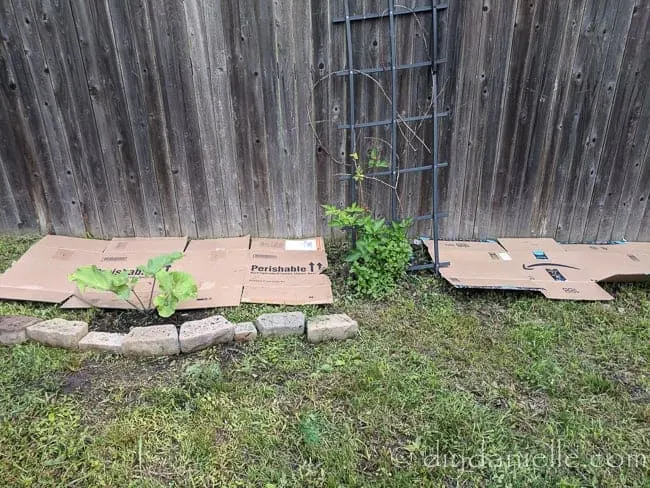

For this job, I also used some weed barrier that they sell for gardens… I had pulled it up out of my old garden and it was in a pile so I figured I’d try to reuse it, rather than tossing it. I DO NOT LOVE this expensive weed barrier… persistent weeds still grow through it, then they embed their roots in it and pulling those weeds is a not so fun game of tug o war. Just my two cents. But I ran out of cardboard boxes and I didn’t want this stuff to end up in a landfill. Save yourself some money and just save up your cardboard boxes though. It’s not a pretty solution but they get my stamp of approval.
Fluff and scatter it.
To spread, I just ripped open the bag and spread it about 2-3″ thick. It is super fluffy so I think it’ll end up as a thinner layer once it settles. The bags I bought were compacted and covered a LOT of area- three bags covered this entire strip. It was a nice mulch option because of how light they are- it made it easy for me to manage them myself without lots of hauling. I’m not a huge fan of hauling bag after bag of wood mulch.
Leave room for your plants to breathe.
Make sure to leave a small area around your plants clear of the pine straw. There should be about a 2-3″ space between the pine straw and your plant base. This gives the plants room to breathe. I probably should have given these a bit more room. I may need to go back out after the rain storm to fix that. I was scrambling to finish up the bed before the skies opened up.
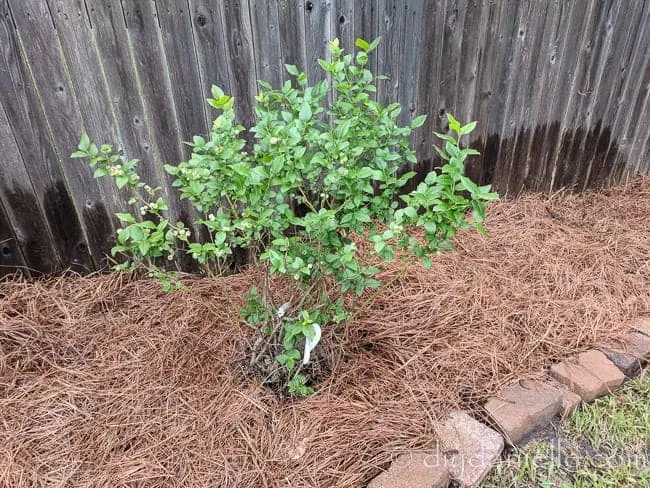
Water your pine straw.
Once you’ve spread your pine straw, make sure to water it down. This should help keep the pine straw from blowing away. I’m a bit concerned about it floating or blowing away, but because it’s against the fence, I’m hoping it will prevent that from happening. I might not trust it as well in the front yard where we get bad winds ripping through the area.
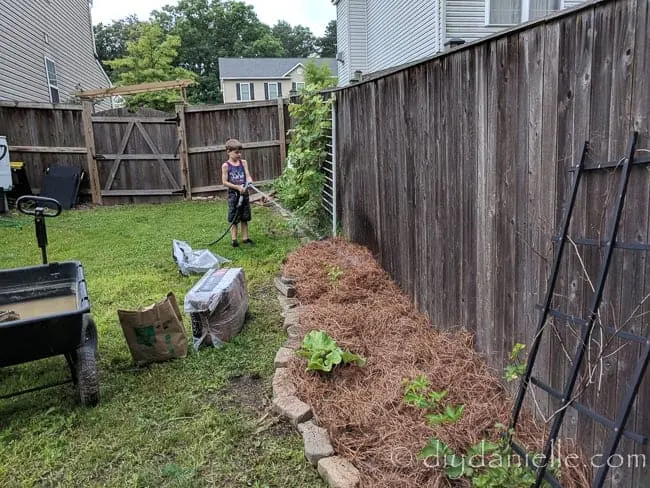
What does Pine Straw Look Like in Front Garden?
I wanted to take a moment to update this post because we’ve since added pine mulch to the front garden at our new house. I’m still trying to decide if I’ll opt for regular mulch next year or not. This batch came in tightly packed bales.
This is the left side of the house before I added the pine straw. I had to do a lot of weeding plus work around the vines I planted… we have a ton of strawberry plants in there that I hope will function as a living mulch later on, as well as a volunteer butternut squash plant on the right.
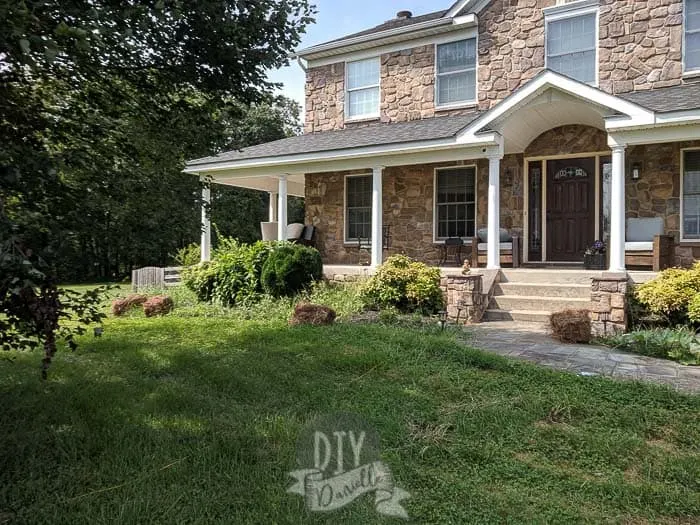
Here is the after photos with my weeding piles still on the path. Note that this is looking pretty fluffy. Once watered down and over time, it sits lower in the soil and isn’t quite so obvious.

This shot is my favorite of the garden and the mulch.
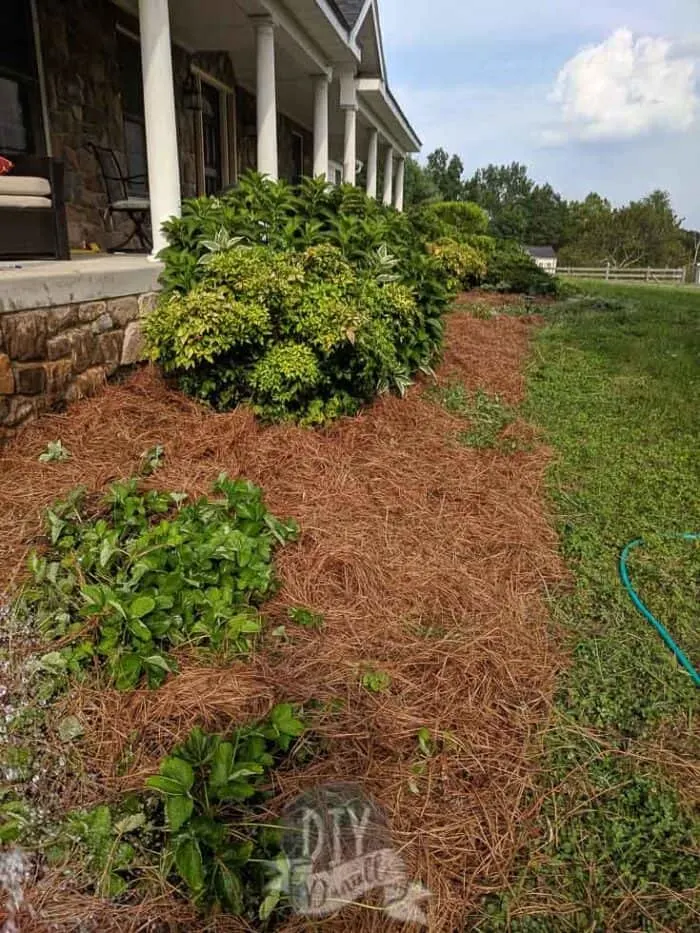
And here’s a photo of the house from afar… it looks nice and tidy from afar, just like it would with wood mulch.
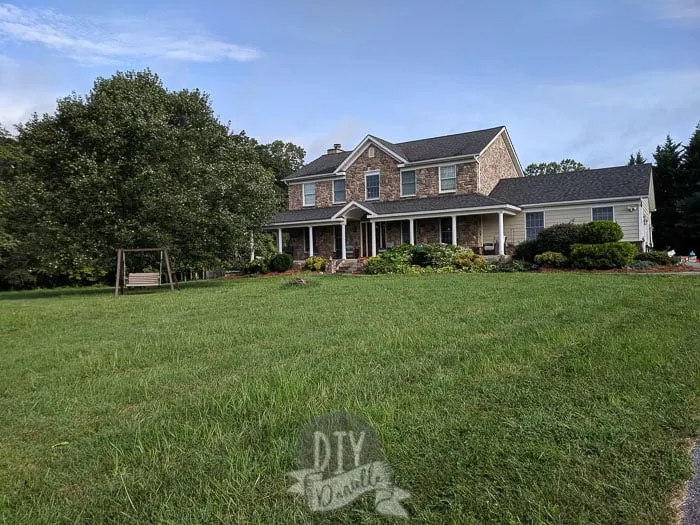
Here’s my favorite weed barriers to use before I plant or lay mulch!
Looking for an alternative to pine straw? Consider using WOOL as mulch! YES! Raw sheep wool! Read more about why sheep wool makes a great mulch and weed barrier here.
And that’s it! Hoping to see good results this year in that garden! I am wondering if I should add a few more vines or bushes. It’s looking a bit empty?
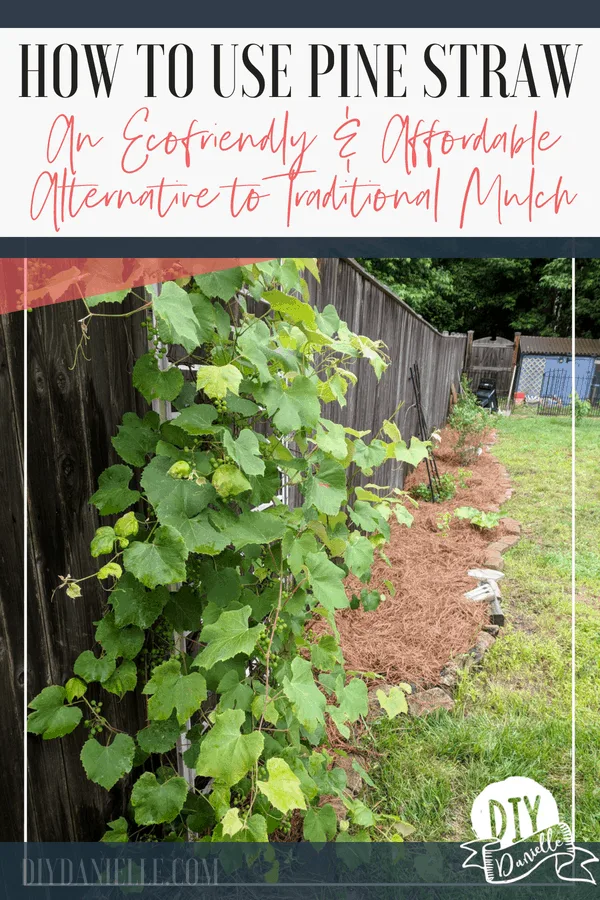

Laurie
Sunday 23rd of July 2023
Hello, This is the first blog I've read about pine straw. I'm in MA. I've been using it for a couple years now in my flower beds. My flower bed has a slope and I love the pine straw for that because it seems water (rain or watering if needed) goes under it. It doesn't get soaked and wash away. I love it for that. Also it's lighter weight which is great for my back. Pine straw spreads quite easily.
Sally
Saturday 28th of October 2023
@Laurie, pine straw also adds nutrients to those plants needing acidic soil. I live in Florida, and those nutrients are essential to growing acid loving plants like azaleas and Camellias. It also doesn’t float away. It does lose its color over time, but that doesn’t bother me. It’s all I use.
Cheryl Velker
Wednesday 8th of March 2023
It does look nice! Wondering how your wooden fence has fared since using the pine straw to mulch. My concern is that it will hold moisture and the wood will rot.
We have pine trees in the yard and so the pine needles are free!
Danielle
Friday 10th of March 2023
@Cheryl Velker, we actually moved so I'm not sure how it impacted the fencing long term. I imagine any type of mulch would have the same issue though. I use it currently in front of my house but the front is stone.